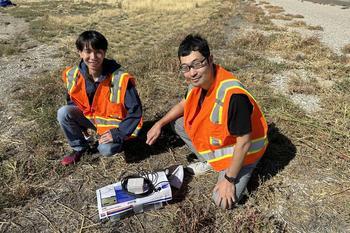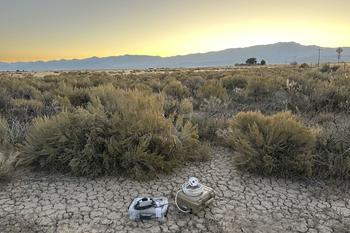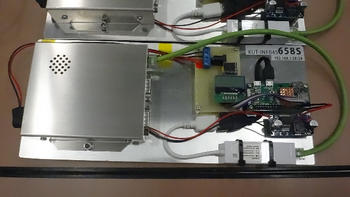- TOP
- NEWS & TOPICS
- Research Associate Yasuhiro Nishikawa an…
2023.10.23Current Students / International / Research / Students Life
Research Associate Yasuhiro Nishikawa and Mr. Yuta Hasumi successfully observe shock waves produced during NASA's OSIRIS-REx capsule re-entry
The sample return capsule of the United States National Aeronautics and Space Administration (NASA) spacecraft OSIRIS-REx landed in the Utah desert on September 24th. Research Associate Yasuhiro Nishikawa from the Space and Earth Exploration Systems Laboratory in the School of Systems Engineering, along with Mr. Yuta Hasumi, a first-year student in the aerospace engineering master's track course at Gunma Prefectural Kiryu High School, observed the infrasound produced by the capsule's impact wave upon returning to Earth.


(From left to right: Research Associate Yasuhiro Nishikawa, Mr. Yuta Hasumi)
This is the fifth time that the Space and Earth Exploration Systems Laboratory has observed a capsule re-entry, the first being the aerial optical observation (camera observation) of NASA's "Stardust" (January 2006, USA). The third observation involved their own infrasound measurement, following JAXA's "Hayabusa" (June 2010, Australia) and "Hayabusa2" (December 2020, Australia).
Infrasound, characterized by frequencies below 20 Hz that are inaudible to humans, can propagate over long distances through the Earth's atmosphere due to its low frequency. Infrasound is generated by natural disasters such as volcanic eruptions, earthquakes, tsunamis, lightning strikes, landslides, and large-scale explosions. Remote infrasound measurement (telemetry) can be utilized for disaster mitigation, including early detection of disasters and analysis of their scale (energy).
This observation was initiated in response to a request from Sandia National Laboratories in the U.S. for advice on their observation plan. Subsequence online meetings researchers from the U.S. and Australia led to an international effort, involving the use of the same infrasound sensors used for Hayabusa2's re-entry, and to the participation of two researchers on site.
The capsule, containing samples from asteroid Bennu and had a diameter of about 80 cm and weighing about 46 kg, re-entered Earth's atmosphere on September 24th, during the daytime. In contrast to previous missions like Hayabusa and Hayabusa2, which re-entered at night, creating shooting star-like streaks in the sky for optical observation, determining the OSIRIS-REx capsule through optical observation was expected to be challenging due to its daytime re-entry. Infrasound observations, on the other hand, are unaffected by ambient brightness and can determine the trajectory with the same accuracy achieved during Hayabusa 2's re-entry.

(An infrasound sensor (INF04 made by SAYA) and a small recording device developed and manufactured by students of the Kochi University of Technology)
The observations were made in Eureka, Nevada, USA, along the capsule's trajectory. A total of 77 infrasound sensors were deployed, with 70 provided by the team from Sandia National Laboratories in the U.S., and 7 brought from Japan. The Space and Earth Exploration Systems Laboratory played an important role in developing five small, portable, and lightweight infrasound sensors (SAYA INF04), which had been previously used during Hayabusa2's return to Earth, facilitating comparisons with past data. Additional instruments such as accelerometers and absolute barometers were also utilized to observe the shock wave generated when the capsule entered the atmosphere and flew supersonically. Through international collaboration, shock wave measurements were successfully obtained from multiple locations.
Further analysis of infrasound data obtained from shock wave observations will refine and test the model used to calculate the sound propagation and other aspects of the flight of a meteoroid passing through the Earth's atmosphere. In addition, refining the relationship between the size and velocity of meteoroids and the characteristics of infrasound will improve how accurately the mass of meteoroids is determined and provide valuable insights into the dynamics of the upper atmosphere.

Research Associate Nishikawa remarked, "I'm glad that our observations were successful. The collaboration with overseas teams from diverse fields of expertise was inspiring. For example, they used balloons and smartphones to obtain real-time observation data. While our infrasound measurements are second to none, we found their operational methods to be quite valuable." Mr. Hasumi added, "I participated in this observation as a part of my master's thesis project, focused on estimating the position, location, and energy of exploding meteors. I'm grateful for this invaluable opportunity. I struggled to communicate with the non-Japanese researchers in English, so I will make every effort to improve my English skills. I decided to participate in this observation only two weeks before departure, which left me with limited time to prepare. I had to arrange my passport and attend classes, highlighting the importance of planning in advance. I also had some troubles on the first day; for example, it took us five hours to check in to the hotel. However, these challenges are valuable experiences. I'm dedicated to the rigorous data analysis ahead."
RELATED POST
関連記事
